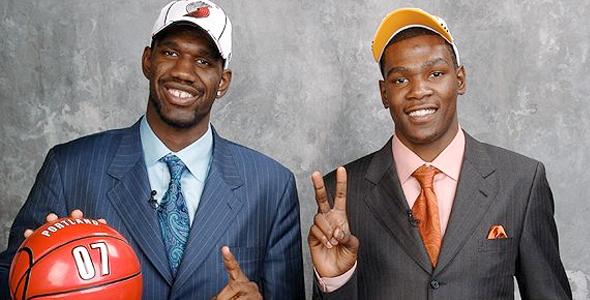As my local radio guy sorted through the mess that is the last few days of the NBA Draft chatter, he wagered a rhetorical question that sports radio hosts tend to extend to their listeners. Whether by thinking aloud or by actual concentration, the airwaves tinged blue at his first mention of the subject.
“Is the one-and-done rule hurting the draft? More importantly, is ‘building through the draft’ a thing of the past in the NBA?” he asked.
The general consensus of this year’s draft is of weakness, project players and total guesses. The reasoning for the one-and-done rule as detrimental to the draft is that this weakness brings an anemic talent pool every few years — that the talent level jumps erratically, players come out under-developed and over-confident and are much harder to project as a smart or safe pick. Couple that with the complaints from fans about the ‘mockery of the student-athlete’ and there’s a sizeable roar against this rule. The insinuation is that NBA teams would benefit from an expanded apprenticeship period of 2-4 years rather than the seemingly detrimental one year requirement.
The proponents of an increased waiting period have a point. The young stars of the NBA today, even the good ones, are still a bit of a project when coming out of college after just one year. Tyreke Evans, John Wall and Derrick Rose could arguably have used more time spent in the college game learning discipline and maturing into an adult emotionally (although Rose less so given his accomplishments). A longer waiting period may also help weed out physical ailments that get NBA teams into a bind contractually. Injury-laden lottery picks like Adam Morrison and Greg Oden may have been avoided had they stayed in college and matured physically (or gotten injured on the collegiate dime).
The counter-balance to this argument comes in two parts. The first is examples like Russell Westbrook who, despite having attended two years at UCLA, failed to help his team in this year’s playoffs due to what most of us regarded as a lack of maturity both mentally and as a basketball player. Second, the numbers for some teams and the jump in wins they’ve gained by acquiring a Derrick Rose or a Kevin Durant is so measurable, to many NBA teams and fans it seems worth the hassle of the draft day guessing game.
So, are NBA teams able to build through the draft in a one-and-done world?
Assessing the question directly may lead us to some answers. Let’s start with the teams from this year’s playoffs. Of the 16 teams in the tournament, all but New York have legitimate franchise cornerstones that they drafted (or traded on draft day):
LaMarcus Aldridge (POR), Dirk Nowitzki (DAL), Kobe Bryant (LAL), Chris Paul (NOLA), Marc Gasol (MEM), Derrick Rose and Joakim Noah (CHI), Paul Pierce (BOS), Kevin Durant and Russell Westbrook (OKC), Dwight Howard (ORL), Tim Duncan and Tony Parker (SA), Danny Granger (IND), Josh Smith and Al Horford (ATL), Andre Iguodala (PHI) and Dwyane Wade (MIA).
The list seems impressive until you consider the one-and-done rule didn’t come into effect until 2005, making Aldridge, Gasol, Rose, Noah, Durant, Westbrook and Horford the only players you can really measure the question against. Even further, only Rose and Durant qualify as one-and-done candidates within this time period, casting even more doubt that NBA teams are able to build through the draft. Rose and Durant are generational talents at their position — their entry into the league is mostly unquestioned and without hesitation. As for the others, the answer remains unclear.
The natural assumption given the question at hand is that, in a pre-one year system, drafting NBA players was much easier given the added factor of comfort knowing they were entering the league with additional experience, both as students of the game and as men. NBA history would tell us otherwise. Sam Bowie, Shawn Bradley, Michael Olowokandi, Jay Williams and Shelden Williams all entered the league after the age of 20. All would have adhered to a multi-year waiting period and all were certified busts.
The NBA draft is an unstable, unpredictable way to build a franchise. They decide who gets the top pick by blowing ping-pong balls around with a vaccum. It is not rocket science. Instead, it is merely educated guesses about over-analyzed prospects by over-educated team officials. Does David Stern have the right to increase the amount of time players have to wait before entering the league? Absolutely. A private business can create whatever standards of employment it wants (save for the iron fist of the Players Association). Will increasing the time spent in college benefit players and the NBA as a whole? Not necessarily.
Building through the draft is something that few teams excel at and most teams strive for. Access to the elite rankings of draft success — Oklahoma City in particular — is rare. In the event teams happen across superstars in consecutive years (or the same year) the difficulty of managing that kind of success and hoping personalities, coaches, owners, wives and money all mesh turns the odds of a team surviving on draft picks alone close to nil. Basketball players are human beings and the choice to remain in school, leave early or skip it altogether is based on myriad factors that no GM can ever fully decipher. The 2011 NBA draft may be a weak class but there will be at least one player who stands out among the rest in five years time. It may be for accomplishments and glory but it could also be because he was the biggest whiff of his class. The great part about the draft is that nothing is guaranteed.
The newest edition to The Hoop Doctors writing staff, Dane Carbaugh is the editor and lead writer of the popular new basketball blog Hardcourt Hoops. Dane is an accomplished author and blogger of both American politics and NBA basketball.




















